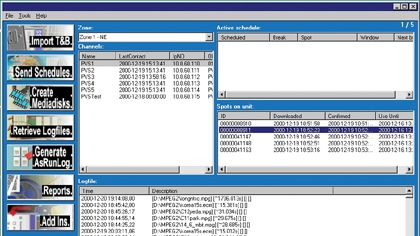Streaming for profits

Come one, come all. Step right up and hear about a technology that costs an arm and a leg, has an increasing variable cost for every new user, and doesn't generate any profits. And, oh yeah, you also need to hire PhDs to run the system. That is the state of streaming media today — not pretty.
Yet, in spite of the fact that a number of very large failures in this area have literally pockmarked the fiber pathways with darkened strands, we're still attracted to digital distribution. Streaming, with all its faults, still commands a lot of attention across the network landscape. As more and more services look for a place to distinguish and disseminate their ideas to a global audience, streaming seems to fit the bill.

Centralized management systems like Pinnacle Systems’ VBase can interface with existing automation and traffic systems to assist broadcasters in generating profits from streaming services.
But the economics of streaming leave a lot to be desired. Servers, bandwidth and the people required to run streaming services place a heavy toll on the cost structures of today's streaming operations. And once we start talking about scaling these operations, the issues become quite acute.
Here's the way most media-streaming servers work in today's unicast environment: Upon request from a client's software, a port is requisitioned, the server allocates it, and the stream begins to flow from the server to the user. Certain small amounts of user and technical information flow back to the server.
These “media transactions” create an enormous amount of traffic along the server's bandwidth-limited backbone. This leads to a limit on the number of ports a single server can support — usually in the low 1000s. While this is acceptable on the small scale, it creates nightmares when tens of thousands or more streams are being accessed. For every additional media transaction, bandwidth requirements increase. Some large-scale streaming operations push in excess of 2 GBytes/s. That's a lot of data, and the cost of the bandwidth is staggering.
Many people were expecting MPEG-4 to be streaming's savior. But they were disappointed recently when MPEG LA, the group that controls licensing and the pricing of the patents, released the costs. At approximately two cents per hour per stream with no cap on the amount, streaming seems to be the hardest hit of all the uses. The problem with this is that if a user has access to a stream for a month, as in a subscription service, the service provider owes a two-cent fee each time the user views the stream. This is not the case with download material and it may make the distribution of media in MPEG-4 less advantageous for streaming.
The professional video industry's #1 source for news, trends and product and tech information. Sign up below.
Add to that the administrative task of managing multiple server clusters, probably in multiple locations, and you can see that streaming in a big way is not for the faint of heart.
Is streaming worth it? Should we invest in the future of streaming? Is there any money to be made?
Well, bluntly, the answer is yes to all the above. Streaming has an immediacy that downloaded content just cannot duplicate. It's just like broadcast, only it's available when you want it or need it. Sure, we love our VCRs and our TiVos, but watching a football game that has been recorded just doesn't have the same impact. Immediacy ranks high on the list of reasons for streaming.
In addition, streaming, unlike broadcast, can have global reach. We are all becoming extremely aware that the market for our content needs to reach beyond the traditional borders of our geographic market. Even more importantly, our streams need to reach beyond the devices our clients typically use — the PC and the TV. It is now possible to stream content directly to new devices. In the near future, CD/radios with Ethernet ports, 802.11a wireless display devices, cell phones, and untethered gaming consoles and other devices will demand the attention of our streaming servers.
New services being developed for portable, connected and reconfigurable devices will begin to drive the use of streaming media, something that could not be accomplished with traditional broadcasting.
Bandwidth issues continue to compress as new and better codecs are introduced. Lately, we have seen video in the under-1 MByte range that is dazzling. There is even some at band-widths as low as modem speeds that would make you believe you were watching cable TV. It just keeps getting better; it's truly amazing.
Server densities are also increasing. As engineers develop more specialized server architectures, the port densities are increasing by a factor of two to three, and possibly will be much greater in the future. Increasing port density brings a number of cost savings. Greater density means less co-location real estate, less power, less air conditioning, fewer pieces of hardware and, most importantly, lower administrative costs.
Streaming is here and it's making a big push forward. Now is the time to invest or reinvigorate investment in the marketplace and prepare yourself for greater revenues coming from unsuspected places.
Steven M. Blumenfeld is vice president of technology, AOL Time Warner CTO's office.
